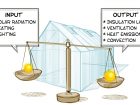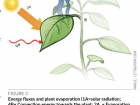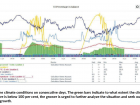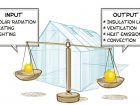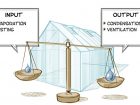
Features
Structures & Equipment
Ventilation
Empower plants through well-balanced ventilation
Rather than aiming for a preset greenhouse temperature, ventilation should be used to support the plant’s water and CO2 needs.
June 10, 2019 By Jan Voogt
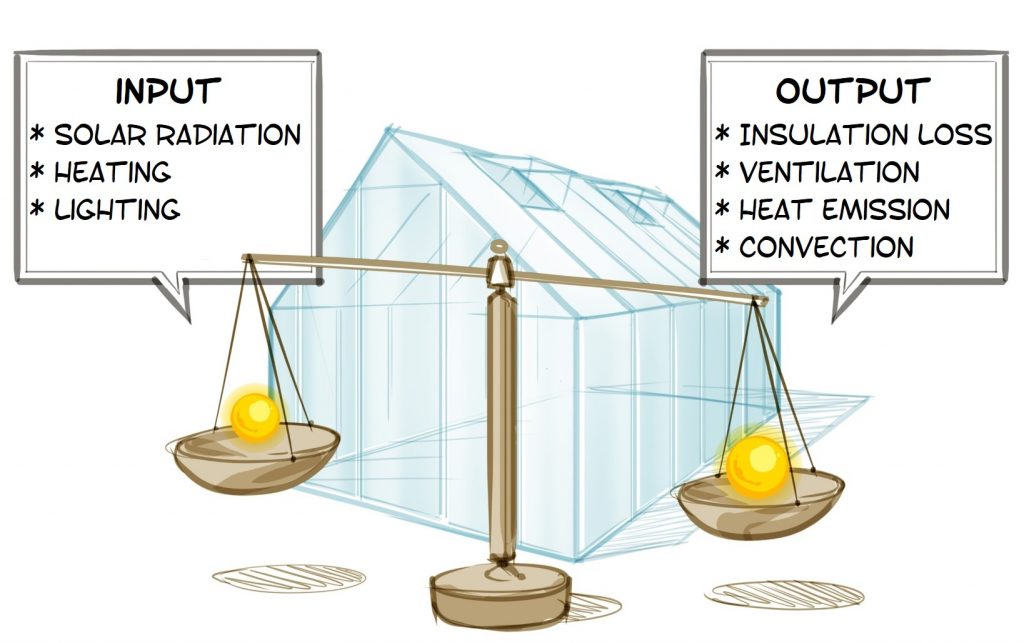 FIGURE 1. The energy balance of the greenhouse Image from: LetsGrow.com
FIGURE 1. The energy balance of the greenhouse Image from: LetsGrow.comIn January’s issue of Greenhouse Canada, readers were introduced to the concept of ‘Growing by Plant Empowerment’ (GPE). Combining grower experience and knowledge of plant physiology, the goal of GPE is to optimize the behaviour of plants in the greenhouse environment by maintaining critical balances involving energy, water, CO2 and assimilates within the plant.
These balances can be monitored by sensors, combined with crop measurements, then interpreted in the context of plant physiology and physics to help finetune and improve the crop.
In the first article of this multi-part series on GPE, the importance of a greenhouse’s irrigation strategy, in relation to the water balance of the plant, was explained (see article from March/April 2019 here).
In this second article, we will explore the importance of GPE in a greenhouse’s ventilation strategy, focusing on the relationship between ventilation and plant evaporation, and eventually how a well-balanced ventilation strategy can promote photosynthesis and light use efficiency (LUE).
Well-balanced ventilation
Typically, a ventilation strategy consists of a mixture of different methods. First, there may be a minimum window opening needed to avoid a build-up of adverse gases like NOx, ethylene, etc. The release of moisture may be another reason to increase the angle of the window opening, which also depends on weather conditions. Typically, the main driver for large window openings is temperature control. It is often believed that temperature is the key to plant development, and that a too-high temperature reading must be avoided at all times.
The ultimate goal of the ventilation strategy, however, should be to support the plant’s water balance and to ensure CO2 uptake for photosynthesis by keeping the stomata open under high radiation conditions. This maximizes LUE and production of assimilates for growth and development. Therefore, ventilation should be used to achieve the right combination of climate conditions, rather than simply reaching a specified temperature.
The energy balance of the greenhouse
First of all, a few words need to be said about the energy balance and the moisture balance of the greenhouse.
Figure 1 shows the different energy flows that, together, form the energy balance. The Law of Conservation of Energy says that the output must equal the input. It is essential to note that the energy balance is largely influenced by greenhouse temperature relative to the temperature outside. If the temperature outside increases or decreases, the greenhouse temperature will rise or drop accordingly because different elements of the balance are determined by the difference in temperature between indoor and outdoor, rather than its absolute value. As a result, the greenhouse climate is strongly affected by weather conditions. Moreover, the energy balance is linked to moisture balance, as will be explained in the next section.
The moisture balance of the greenhouse
Figure 2 shows the different input and output moisture fluxes that, together, form the moisture balance of the greenhouse. The Law of Conservation of Mass requires that, again, the output must equal the input. The moisture balance influences the absolute humidity of the greenhouse air, measured in grams/kg dry air, or grams/m3 air. Taken together with air temperature, this allows us to calculate the relative humidity (RH).
The relationship between absolute humidity and air temperature is described by the well-known psychrometric chart. It is beyond the length and scope of this article to elaborate too much on the characteristics of humid air that can be found on this chart. For those who are interested, there is an online version of the psychrometric chart available at
http://gpe.letsgrow.com/psychro.
Typically, a large part of the energy from solar radiation is “absorbed” by the crop and “converted” to water vapour (latent heat) by evaporation. This is why the energy balance and moisture balance of the greenhouse are closely linked. The greenhouse climate is a result of the interaction between greenhouse conditions and crop activity. The same goes for the greenhouse’s energy balance, moisture balance, and CO2 balance.
Now, let’s look at how we can optimize photosynthesis using greenhouse climate control, with particular emphasis on ventilation strategy.
Evaporation of the plant
Plant evaporation is driven by energy supplied by both radiation and convection. Radiation is, in principle, independent of the conditions of the air. Neither air temperature nor humidity will influence this. Convection, however, depends on air movement and the temperature difference between the leaves and the air. When leaf temperature is lower than air temperature, convection energy contributes to plant evaporation by moving heat towards the leaves. If, however, the plant temperature is higher than air temperature, convection helps keep the plant cool by moving heat away, and decreases the need for evaporation.
The role of air humidity
It is well-known that a low relative humidity (RH in %) or a high humidity deficit (HD in grams/m3) promotes plant evaporation. The latter can also be expressed as vapour pressure deficit (VPD in kPa). Unfortunately, there are some misunderstandings around VPD because this abbreviation can have two different meanings, namely vapour pressure deficit or vapour pressure difference.
Vapour pressure deficit depends only on the condition of the air and is just another way to express HD. Vapour pressure difference is the difference between the water vapour pressure inside the plant’s leaves and the vapour pressure in the air. This VPD can only be calculated if the plant’s leaf temperature is being measured, for instance with an infrared sensor. Our previous article mentions how VPD should not exceed 1.5 – 2.0 kPa for most types of crops, because this indicates water stress.
In general, a low RH, and hence a high HD and vapour pressure deficit, leads to a lower leaf temperature in relation to air temperature. This doesn’t necessarily imply a high vapour pressure difference, as long as water availability inside the plant is sufficient and stomata are open enough to let in CO2. As a result, total plant evaporation is high, because convection contributes to the input energy supplied. Under high radiation conditions, however, the total evaporation rate may be faster than the plant’s rate of water uptake, and stomata will start closing in order to maintain water balance and avoid dehydration.
The first direct result of stomatal closure is an increase in leaf temperature. Evaporation is hampered, and as a result, the energy balance has to shift to a new equilibrium state. This is found at the point where the lower evaporation rate matches the lower influx of convective energy. This way, the energy and water balances are restored, but at the cost of a lower CO2 influx because the intake through the stomata has been reduced.
This problem becomes even more severe if RH is lowered further. To reduce the evaporation rate, the stomata now have to close even more and CO2 uptake is restricted even further. In contrast, if the RH were higher, the degree of stomatal closure would be less, and the plant would be able to control its water balance more easily without affecting CO2 uptake too much. In other words, a high RH allows the plant to keep its stomata more open, even if it has to restrict evaporation to some degree.
Other articles in this series
- Empower plants through well-balanced climate control
- Empower plants through well-balanced irrigation
- Book overhauls concepts in greenhouse production
- Empowering plants: Balancing biochemistry
The effects of the common ventilation strategy
The usual ventilation strategy focuses mainly on moisture exhaust and air temperature. Let us now take a look at this from the perspective of LUE.
Under high-radiation conditions, greenhouse temperatures tend to reach 30°C or higher. For most growers, this is one reason to open the windows further. As a result, the exhaust of moisture and, in the case of CO2 enrichment, the loss of CO2 through the vents is accelerated. The decreasing RH, however, increases plant evaporation which, most likely, leads to further closing of the stomata. At the same time, in the case of CO2 enrichment, the CO2 concentration in the greenhouse decreases. Together, this leads to greater plant stress and poor photosynthesis.
An improved strategy based on plant empowerment
Now let us think of a different strategy that aims to support the plant balances.
Under high radiation conditions, we would like to maintain LUE at a high level. This means that the stomata must be kept open as much as possible to let CO2 in, so the plant can benefit optimally from the available PAR light. In the previous section, we explained that this can be achieved by increasing the RH, closing the vents further instead of opening them further. This also restricts CO2 loss by ventilation. Both effects promote photosynthesis and LUE.
The commonly expected steep rise in greenhouse temperature does not occur due to two reasons. First, warm moist air can contain much more energy (also called enthalpy) per m3 than dry air. So if RH is higher, the same cooling capacity can be achieved by a much lower ventilation rate in m3/m2·hour. This can be easily derived from the online ventilation simulation model provided by LetsGrow.com (http://gpe.letsgrow.com)
Second, when the crop is less stressed, plant evaporation is kept going and more solar energy is absorbed by the crop, resulting in better cooling of the greenhouse.
What if crop evaporation capacity is too low?
Depending on the type of crop, as well as the crop stage, there may be an imbalance between radiation intensity (W/m2) and crop evaporation capacity (grams/m2·hour). In that case, keeping a high RH within the greenhouse may require extra instruments such as a high-pressure misting system or something similar.
As an alternative or additional measure, white wash could be applied or a retractable shading screen, preferably a diffuse type of screen, could be used above the crop.
It must also be mentioned that the photosynthetic capacity of the crop, expressed in a maximum PAR (photosynthetically active radiation) level in micromoles/m2·s, can require the application of white wash or shading screens. The history of ‘Next Generation Growing’ in The Netherlands has shown, however, that what was believed to be light stress in many crops actually appeared to be water stress. Thanks to this new insight, a higher PAR light level can now be tolerated in combination with a higher RH level under high radiation conditions. As a result, higher growth rates and better production and quality can be achieved.
The Letsgrow climate monitor module
LUE is mainly determined by four climate factors: PAR level, CO2 concentration, humidity (RH and VPD), and temperature. Now the question is, how do we continuously monitor all of these factors in order to know which factor is the limiting one that should be improved to push LUE to the max? For this purpose, the LetsGrow.com online climate monitor was developed. This climate monitor module provides growers with a very powerful tool to assess the realized growth conditions at a glance.
The starting point is that optimal growth can be achieved by aligning air temperature, humidity and CO2 concentrations with the actual radiation or PAR light level.
The grower can enter the desired climate conditions depending on the irradiation/PAR level. For each condition, a minimum and maximum value can be defined, where the range in values is considered “optimal”. The grower defines, for instance, that at a PAR level of 300 micromoles/m2·s, the temperature should be 24 to 25°C, RH should be between 60 to 70 per cent, and CO2 should be between 450 – 500 ppm.
The climate monitor continuously scans all of the parameters. If all are within the predefined range for the given irradiation/PAR level, the score is 100 per cent. If one or more are out of range, the score is lowered depending on the degree of deviation.
Summary
Ventilation should be aimed at allowing the plant to optimally benefit from the available light for photosynthesis. In practice, different strategies can lead to reasonably good results. The best ventilation method, however, takes the energy and water balances of the plant as a starting point, and strives towards the best combination of PAR light level, CO2 concentration, humidity (RH and VPD) and temperature, thus optimizing photosynthesis and LUE. In many cases, this can be achieved by just keeping the vents more closed under high radiation conditions.
Learn more about Plant Empowerment
GPE is based on the same principles as ‘Next Generation Growing’ (NGG), developed in the Netherlands over the last 15 years. It has been shown that this approach can deliver significant advantages regarding production and quality, plant health and energy savings for many different crops. For the most part, this can be achieved without extra investments in greenhouse equipment.
The basic principles have been further developed, refined and extended, focusing on optimal growth in a sustainable way and going by the new name ‘Growing by Plant Empowerment’. For more on GPE and the book Plant Empowerment: The Basic Principles, visit plantempowerment.com. Copyrights of text and illustrations: LetsGrow.com, 2019.
Jan Voogt is a senior researcher at Hoogendoorn Growth Management and is one of the authors of Plant Empowerment: The Basic Principles.
Print this page
